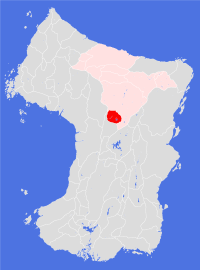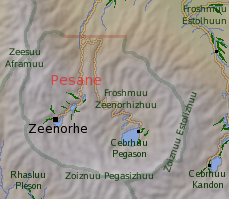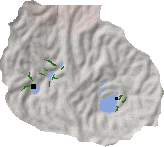Pesane

Societal ties: Ambostak
Current population: 1
Main language(s): Ramajal (alongside many other languages)
Area: 108,000km²
Natural and political borders
Pesane is surrounded on all sides by mountains - clockwise from the east Zoiznuu Estolishuu, Zoiznuu Pegasizhuu, Zeesuu Aframuu. The Land controls the Zeenuu and Pegasuu valleys south of latitude 27.6°N.
History
Following the establishment of the Land of Gromane in gt1102, the Ambostak Lands commissioned a scientific exploration of mountains to the south of the Gromane plateau. The first expedition set out in gt1108 to map the Zeenuu valley, following which a decision was taken to build a soil research centre in the valley (in gt1113). By gt1120 work had started on constructing a more permanent settlement around the southernmost lake in the valley - work which had to be put on hold in gt1123 when scientists realised that the lake played host to a unique aquatic Type Two lifeform oasis - the Zeenuu Ark, which included algae, plants, crustacea, molluscs and fish.
Zeenorhe settlement was officially completed in gt1128 - the first orbit that the nascent University of Pesane accepted students. The settlement continued to grow, becoming a city in gt1159 when the population passed the 20,000 mark. Such growth had not been part of the original plan for the settlement; however in gt1125 the University and its sponsor Lands signed an agreement with the leading Istran Society universities to build a series of telescopes in the surrounding mountains, which led to a major expansion of the settlement. Study of the Zeenuu Ark also attracted many scientists and researchers from other Societies.
Mapping of the Pegasuu valley did not start until gt1135, mainly because people did not realise that the valley existed - the valley entrance, 60km east of the much wider Zeenuu valley entrance, is narrower, higher and easy to miss. The discoveries made in the Pegasuu valley, not least Cebrhuu Pegason itself, continue to amaze and confound scientists from across the continent.
With the importance of the discoveries being made in the two valleys becoming more widely known, the pressure from the scientific communities across the continent to visit Zeenorhe and (possibly most importantly) the keenness of Lands and business enterprises to exploit these discoveries, a decision was made in gt1139 to give the resident population some control of the situation by declaring the region to be a Land in its own right.
During the gt1140s Istran and Ambostak researchers experimented with the ancient technology of rockets - a controversial decision, given their legendary dangers. In gt1148 the Pesane authorities agreed to limit rocket research to just one specific purpose: the deployment of communication satellites. In gt1153 the first communications satellite to be built in over eight centuries was launched by the Pesane scientists (from a base in the Zoiznuu Thagizhuu, in the Telik Land of Talhe), kick-starting a new communications revolution.

Politics and economy
Politics in Pesane has always been a complex affair, mainly because most of the people who work and live there are not permanent residents; loyalties to Pesane often seems to conflict with loyalty to home Lands and Societies, or loyalties to particular scientific disciplines - the rows between the astronomers and the biologists have become legendary. To cope with such a tense situation, the Land has developed a unique and complex system of democracy which attempts to balance the differing needs of each section. The system is still evolving as the permanent population grows - for instance the authorities have had to develop services to cope with both children and the elderly, two demographics which have grown swiftly over the past three decades.
The only export of any worth the Land has is knowledge; for most of its existence Zeenorhe has been heavily dependent on other Lands for even its most basic requirements. The need to establish some sort of revenue stream became obvious as the treaty of Pesane establishing the Land was being negotiated. The solution - to charge Lands and enterprises time-limited licences to make use of the University's discoveries - was innovative, and has been adopted and adapted by many other Lands over the past few decades.
A second (much smaller) revenue stream has been the export of fish and other aquatic animals from the Zeenuu ark. The trade began between universities as a way of spreading the workload of studying these unique organisms. As the knowledge of how to keep and breed the fish has developed, so has a new hobby: owning an aquarium is now a status symbol among the richest people in Ewlah.
Culture and other issues of interest
In many ways, the biggest experiment undertaken in Pesane is Pesane itself. For the first time people from many different Lands and Societies have come together in difficult and unusual circumstances and have had to learn to cooperate and adapt to each others needs and requirements. With so many cultural influences represented in the Land, it will be interesting to see whether a distinct, new culture develops over the coming decades and centuries.
Key natural features
Pesane consists of mountain ranges bisected by two deep valleys that empty into the Gromane plateau to the north. The western valley - Zeenuu - is a largely dry valley with a series of lakes along its length - one of these lakes is unique in that it hosts the only aquatic Type Two lifeform ark ever discovered on the planet. Construction of the city of Zeenorhe, on the shore of the lake, was almost complete when the discovery was made, requiring a complete redevelopment of the city to minimise the risk of contamination.
North of the city lies Mt. Zeene (6,540m), which hosts most of the astronomical instruments developed for investigating the skies on its slopes. Other significant mountains in the Land include Mts. Aframe (6,970m), Piesuu (4,810m), Pegazjarhe (6,620m), Pegasnise (6,340m) and Estolhuu (4,700m).
The eastern valley - Pegasuu - is no less remarkable than the western valley. The dry valley itself runs a tortuous course southwards, with a number of branches and joints, before descending towards Cebrhuu Pegason, an almost circular lake at the base of an almost circular depression. The question of how this feature evolved has been fiercely debated for decades - a long-running theory that it is the result of a massive meteor impact appears to have lost support in recent years in favour of it being a natural feature formed as a result of geophysical activity associated with raising of the surrounding mountain ranges. The lake itself is slightly warmer than it should be for its latitude and altitude, and is also slightly briny rather than freshwater.

Habitats
Almost all of the Land's territory falls within the north central mountains habitat.
Plantations and settlements
Zeenorhe Plantation is remarkable in having the highest cultivations on the continent (and indeed the planet). It is also remarkable in that all its cultivations fall within the central mountains habitat. The cultivations are almost all protected and enclosed, as most of the cultivated soils collapse if exposed to the local climate - only the newest cultivations at lower altitudes are open to the local conditions, though development of cold-resistant and oxygen-poor soil organisms continues to progress. All of the plantations are below the city and away from the city lake, to prevent the aquatic ark from being contaminated.
A settlement has also been established in the eastern valley which, while being continuously occupied, does not have any permanent settlers.
Key towns and cities
Rural population: 0 (0.0% of total)